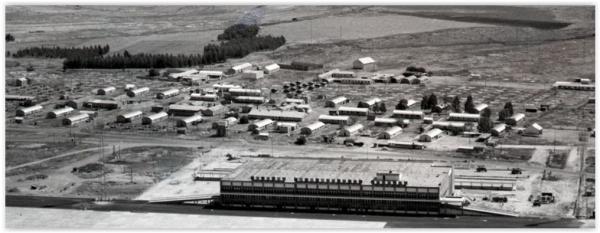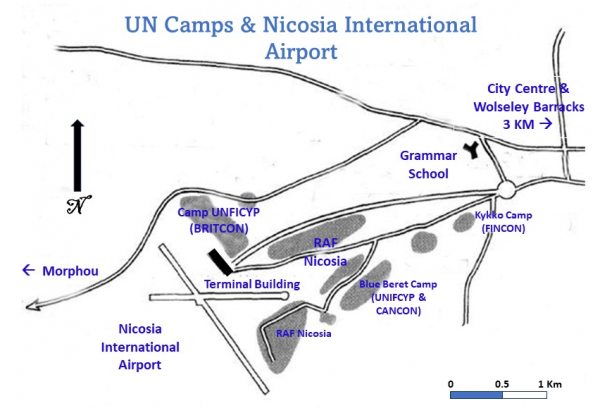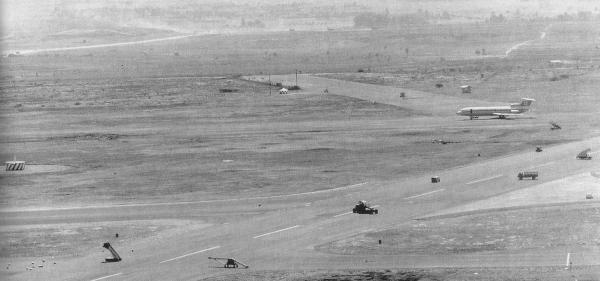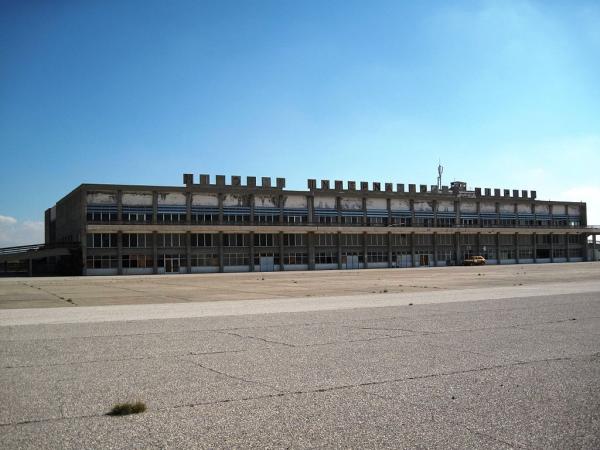This is the third in an evolving series describing sapper participation in Cyprus during the time of the Turkish Invasion in July and August 1974.
- Cyprus '74 - The Sapper Story Part 1 Introduction
- Cyprus '74 - The Sapper Story Part 2 - Kyrenia
- Cyprus '74 - The Sapper Story Part 3 - The Initial Defence of the Nicosia Airport
The Coup

at Wolseley Barracks
CANCON HQ located at Wolseley Barracks in the city of Nicosia, learned of the coup d’etat early on the morning of 15 July when UNFICYP HQ called a general alert. In the early hours of the coup, confusion allowed UNFICYP to get President Makarios out of Nicosia before he was captured by the rebels. He was quickly flown to safety in Malta from the RAF base at Akrotiri. Over the next few days, British and American negotiators worked hard to reach a peaceful settlement but were unable to find a solution to which Greece and Turkey as agree as required by the Treaty of Nicosia. A key part of that treaty concerning the establishment of the Republic of Cyprus was to guarantee the independence and territorial integrity of Cyprus and not to promote the union of Cyprus with other states or partition of the Island.
Following a brief period of fighting, the Cypriot National Guard demolished the Presidential Palace, heavily damaged the House of Representatives, and a police station. Access to UNFICYP HQ at Blue Beret Camp (BBC) adjacent the Nicosia International Airport and some five kilometres away, and to CANCON’s logistics and administrative base also at BBC, was blocked. By noon, the National Guard was in control of the city.

The Greek Point of View and the Turkish Reaction
The Greek side tried hard to convince other parties that the coup was an internal Greek Cypriot affair and would not affect the Turkish population. However, their aggressive actions said otherwise. Over the next few days, there was sporadic shooting and a partial curfew as the leaders of the coup tried to sort out the mess they had created. The Turkish population was in a constant state of fear and the main goal of CANCON was to prevent any outbreak of violence along the Green Line. Meanwhile, across the sea, Turkish forces started assembling at Mersin on the mainland in response to the coup. In the time between the coup and the Turkish intervention five days later, only the steadfast actions of Canadian soldiers on the OPs and the active patrolling of the Green Line by Recce Platoon prevented turning an “intra-communal” conflict into an “inter-communal” conflict.
In the early morning darkness of 20 July, Turkish radio warned that Turkish armed forces had begun landing in Cyprus to assist the Turkish Cypriot population. Turkey launched a series of air strikes against Nicosia and Kyrenia and troops began to land on the plain north of Nicosia. At first light, the naval landing had started in Kyrenia. The Canadian Contingent (CANCON), commanded by Colonel Clay Beatty, was put on full alert, OPs were double manned, and all activity was reported to UNFICYP HQ. Within hours, Turkish fighter jets began their bombing of Greek National Guard encampments and towns while protecting a Turkish airborne landing on the plain north of the city, within the Canadian Sector. Mortar attacks and strafing runs put everyone in the line of fire. Seven paratroopers were wounded at Wolseley Barracks by shrapnel and rifle fire.
By noon, an airborne brigade had been landed and assembled just miles north of the city. Fighting broke out and many of the Green Line OPs, which at that time were often no more than wooden sentry boxes, began to take fire. Other UN Locations were also subject to Turkish fire and the Greek Cypriot National Guard purposefully located mortar and artillery positions within or close to the UN lines to somehow avoid Turkish fire. At the same time, considerable Greek fire was directed at the Ledra Hotel in the vicinity of Wolseley Barracks. The hotel was the highest building in the city and offered a significant advantage in controlling movement within its view.
Securing the Airport

The UN camp where UNFICYP HQ, British and Canadian support units, a Canadian rifle company and a portion of the Finnish Contingent (FINCON) were stationed were located, was on the northwestern outskirts of the city adjacent to the Nicosia International Airport. As soon as they knew of the coup, the CANCON Logistics Company executed their battle plans and set up the perimeter defence for UNFICYP HQ, manned checkpoints, moved their ammunition to a more secure spot, and loaded support weapons and ammunition onto the appropriate vehicles ready for deployment under direction of the company second-in-command. The rest of CANCON - RHQ, a rifle company and the D&E Section, were five kilometres away in Wolseley Barracks and completely cut off on the morning of the coup.
The coup leaders had closed the airport to civilian traffic on 15 July. UNFICYP HQ expanded the role of the CANCON Logistics Company to include guarding the airport along with their defence of the UNFICYP camp. They were deployed to the Nicosia International Airport to provide as much security as they could given their limited fighting resources. The airport was briefly re-opened on 17 July to ferry troops from Greece to Cyprus. The following day, the airport was reopened to civilian traffic under the control of Engineer Major Dave Harries, OC Logistics Company. What ensued can only be called a chaotic mess as holidaymakers and other foreign nationals tried to leave the island. In addition to providing airport security, Harries oversaw airport operations including the customs and customs warehouses, the terminal building, traffic control in and about the airport, and running the functions of the small air movements unit.

When the Turks landed on 20 July, the airport was directly in the path of the Turkish invading forces and was the key objective of the airborne landing operation. Greek Cypriot forces moved in to defend the area. Understandably, the International Airport was deemed a critical facility that had to be protected, but more than that, it was a major objective of the Turkish airborne landings. In more than one sense, the airport also represented the keys to the city of Nicosia – control the airport and you control the city. This put the Canadians in the crossfire between the belligerents. Most passengers unable to leave before the landings were mostly evacuated to Blue Beret Camp. Most airport workers sought shelter in the UNFICYP Camp. Neither place was safe as Camp UNFICYP had been hit by rocket, bomb, cannon fire as well as napalm. Mortar rounds hit Blue Beret Camp as well.
Reacting to the landing of Turkish troops, UNFICYP HQ created the Nicosia International Airport Task Force with Major Harries remaining in command. He was given elements of Recce Platoon, the field engineers from Pioneer Platoon, the D&E Section, and clerks, mechanics, drivers, and cooks from his logistics organization. Finding men who could operate submachine guns and 106 mm anti-tank guns, a hasty defence was quickly established. Had the Turks attacked, the small force would not have had the strength to repel a full-on attack, but it was obvious they were not leaving and were ready to fight to the end.
Sergeant Tom Walton, 1 Airborne Field Squadron, was instrumental in this part of the operation. Initially in charge of both Greek and Turk UN civilians at the airport, he then led in the hasty occupation of the Nicosia Airport, helped negotiate local ceasefires, clearing buildings and rendering safe OPs and trenches. Over the next few weeks, he was assigned many VIP security details.
The Turks Attack
On 21 July, the Greek Cypriots continued to reinforce their positions at the airport while the Turks continued their air campaign aimed at neutralizing the airport. During hours of darkness, the Greeks repaired craters and other runway damage in preparation for receiving reinforcements and resupply from Greece. The situation became more perilous on 22 July when military aircraft flying in from Greece started bringing more supplies and reinforcements through the airport successfully landing 200 commandos and supplies proving the airport’s value. But the flights added more chaos and danger to the situation. If Greece could potentially re-supply its allies faster than Turkey, the Turks would need to remedy the situation quickly. The cost of inaction was to risk losing their gains by further Greek re-supply efforts. The fighting only increased in intensity. Turkish tanks and infantry moved northwest along Morphou Road toward the airport and reinforcements including tanks and M113 APCs started to arrive from Kyrenia. The Greeks, on their part, brought busloads of reinforcements from the eastern parts of the city.

On July 23, despite Colonel Beattie’s continued efforts to negotiate a cease-fire, it became clear to UNFICYP that the invading Turkish forces had no intention of allowing the airport to remain in UN hands. They attacked at 11:00 AM directing mortar, rocket, and tank shells towards the main terminal complex while Turkish soldiers advanced over the flat and open terrain surrounding the airport. The attack fizzled as the Greek Cypriots, now reinforced with their own T-34 tanks, held their ground including the control tower and other buildings around the terminal. Smoke and flames from the multitude of same grass fires created an obstacle to the advance trapping many Turkish soldiers. With great tenacity, Colonel Beattie again moved between the fighting forces and negotiated a ceasefire in the early afternoon. UN Headquarters in New York (UNHQ) announced the terms of the ceasefire with a long list of provisions stating that UNFICYP would take control of the airport which in effect created a UN Protected Area (UNPA) which included all airport, UNFICYP and RAF areas. The boundaries included a 500-meter buffer on all sides, checkpoints on the Morphou Road, scout car patrols and scheduled visits to opposing side locations. That evening, the UN flag was raised on the terminal building.

as it looks today.
Had the Canadians known the Turks did not recognize the agreement for the United Nations to control the airport, their sleep might have been even more disturbed. Nonetheless, and in full recognition that the Canadians were severely undermanned, they were ordered to stand their ground despite overwhelming odds. Colonel Beattie recalled the situation, “Turkish interest in the airport became obvious as they made allegations concerning the control and occupation of the airport itself. I approached the force commander and suggested that he delegate me with the authority to open fire if the airport came under attack.”
While the Turks had sufficient force to overrun the Canadians at the airport, to do so they would have suffered the world press reporting them mauling a UN peacekeeping contingent and a serious rift with NATO. The loss of Nicosia would be an unacceptable blow to UN peacekeeping credibility. On 25 July, an agreement between UNHQ and the British Government led to the posting of a squadron of British Saladin armoured cars from the southern Sovereign Base Areas (SBA) with British air support on call from RAF Akrotiri in the Western SBA, was added to Harries’ force. Similarly, British infantry was deployed from the Sovereign Base Area to BRITCON. UNHQ requested that the Turkish Government respect the ceasefire.
Aftermath
Though subsequent events would demonstrate the peace was not as solid as it appeared, for the moment Colonel Beattie had performed a significant feat. Although they lost the airport, the city of Nicosia remained in Greek Cypriot hands. On the other hand, the Turkish attack ensured the airport could not be used by the Greeks to reinforce their troops on the island. Interestingly, the international media — but strangely not the Canadian media, hailed the Airborne Regiment as the “saviours of Nicosia.” To the present day, the airport has remained a United Nations Protected Area. Only access by the UN and authorized visitors is allowed. All facilities remain deserted and have fallen into decay. Corporal Wayne Busenius, 1 Airborne Field Squadron was hastily tasked to navigate as Colonel Beattie’s driver on his dash through no man’s land to reach the Turkish commander to negotiate a ceasefire as the Turks approached the UNFICYP camp at the Morphou Gate. Busenius, armed with a UN flag, tactically led the party through barbed-wire obstacles and Greek fire to get Colonel Beattie to the Turkish lines. As Major Harries’ driver, he used his advanced first aid training to tend to many wounded civilians and soldiers as he traversed the danger zone.
Over the next few days, as the dust settled, there was a growing confidence that the ceasefire would hold. Major Harries handed his responsibilities for the Airport over to the reinforced British Contingent and his troops returned to a new routine within that focused on building stronger fortifications throughout CANCON. Within the next few weeks, the Airborne Regiment including 1 AB Field Squadron to their regular establishments and provided with armoured vehicles and support weapons over and above what would have been considered for a routine peacekeeping mission. What happened over the next month including a serious ceasefire will be the topic of the next installment.
Sapper Bravery
There is no doubt that the first defence of the Nicosia Airport relied on the bravery of all the soldiers involved over those perilous days. However, the actions of two sappers in particular bear special attention.
- Cyprus '74 - The Sapper Story Part 1 Introduction
- Cyprus '74 - The Sapper Story Part 2 - Kyrenia
- Cyprus '74 - The Sapper Story Part 3 - The Initial Defence of the Nicosia Airport